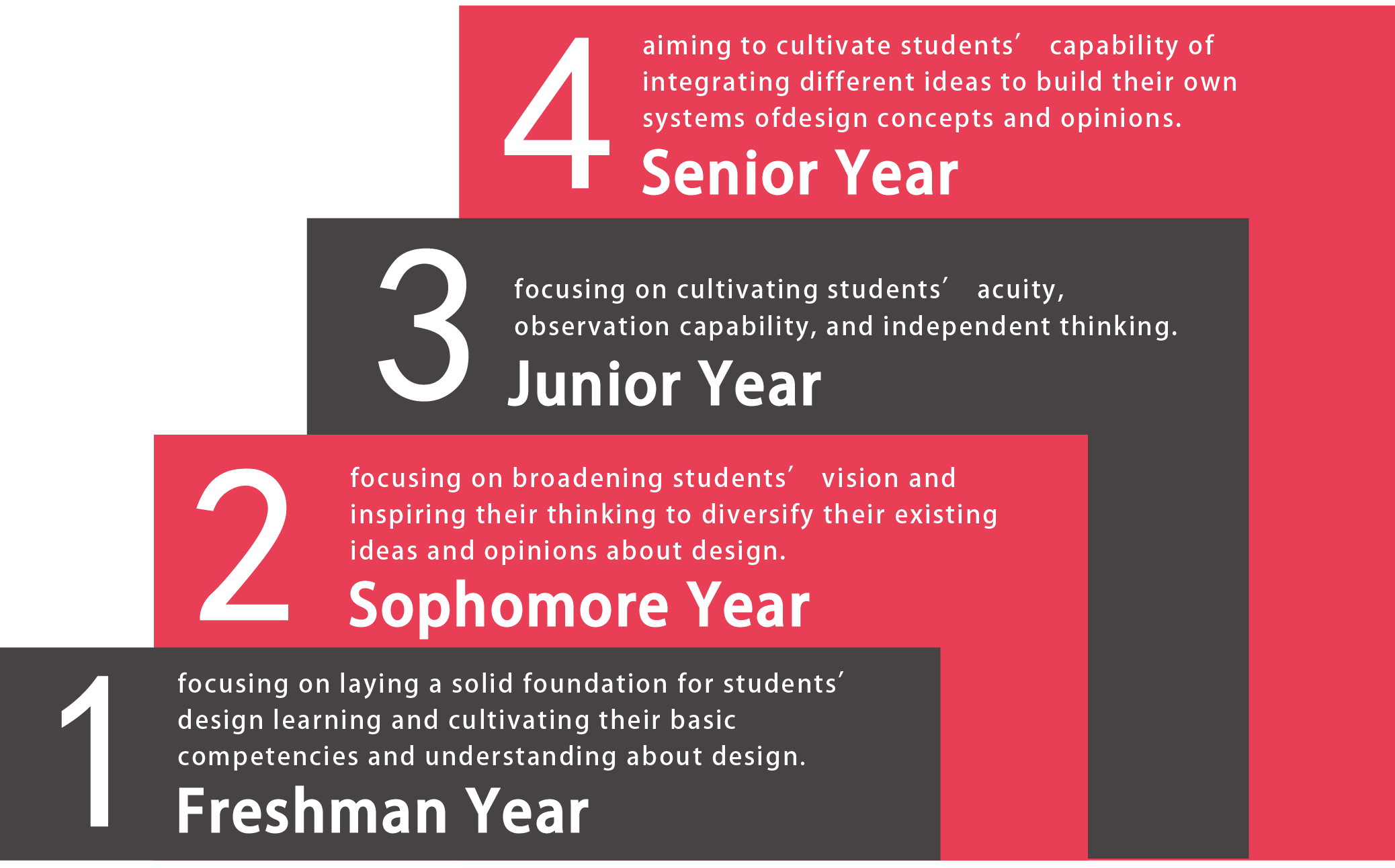
A DESIGN MINDSET FULL OF ENERGY AND INTEGRATING CREATIVITY, RESEARCH AND PRACTICE
Curricular Structure of Our Department
Inresponse to the ever-changing trends of the industrial environment and design development around the globe and also to the government’s proactive promotion of the industries of cultural creativity and digital contents, the courses at our department aim to equip students with professional competencies of advertising design, webpage design, interactive multimedia design, digital content design, 3D animation, marketing and planning, and media application. Seeing the diverse demands for professional design talents from the cultural creativity, digital contents and other industries, the three major directions of our curricular design are
“Print Media”,
“Animation Media Design”and
“Industrial Innovation Design”. Through their group projects in the courses, our students can be trained and equipped with the capabilities of project coordination, communication and implementation. Upon graduation, each of our students will have the potential of becoming a design leader in the new century with his/her media creativity and project implementation capabilities.
- Print Media Design: layout design, visual design, interface composition design and so on….
- Animation Media Design: frame-by-frame and digital 2D animation, 3D animation, interactive game APP, audiovisual design and so on….
- Industrial Innovation Design: craft forum, lifestyle design, material application, prototype design, creative product design, branding and marketing integration, and so on…


Curriculum Field
- Theoretical Thinking:
Western Art History, Thoughts in Modern Arts, Aesthetics, Copyright, Design Originality, Psychology of Visual, Visual Symbol Culture
- Basic Design:
Use of Colors, Typography Layout Design, Perspective, Visual Formation and Materials, Programming, 2D Media Expression
- Visual Design:
Edition Design, Visual Communication Design, Information Visualization Design, Packaging Design, Printing Production&Management, Advertising Planning, Advertising Design, Planning Design of Exhibition Planning Design, Design Management, Design of Image’s Planning, Planning of Design Industries, Creative Industry Planing, Practical Design, Desktop publishing, Picture Book Design, Package Structure Design, Book Binding DesignDesign Workshop
- Digital Media:
Computer Digital Image Photography, Web Page Design, Interactive Media &Web Page Design, Motion Design, Non-Linear Editing, Interactive programmin, Video and Sound Design, Advanced motion graphics
- Audiovisual Design:
Commercial Photography, Digital Photography, Script and Story Board
- Painting Media:
Basic Drawing, Illustration, Creative painting
- Motion Graphics Design:
Anatomy of Arts, Virtual Reality Modeling, Texturing Design, Acting for Animators, Character animation design, Effects, Lighting of Animation, 2D Animation
- Product Design:
Process culture, Form Structural Design, Merchandise of Lifestyle Design, Product Development, Applied Physics, Craft Forum, Prototype Design, Material Production, Creative product design, Branding and Marketing, Commodity Image Planning
- Integration Curricular:
Projects Design, Portfolio, Special Topical
I. Energy of Certification
Preparing Students for Professional Certification through Our Teaching & Strengthening Their Practical Professional Skills
Incorporating teaching contents related to professional certification both at home and abroad into our courses to equip students with the professional knowledge and competence required by the industry.
- Freshman Year: incorporating teaching contents related to entry-level certification into the courses of “Computer Image Processing” and “Computer Illustration” (example: TQC + image processing)
- Sophomore Year: incorporating teaching contents related to mid-level certification into the course of “Webpage Design” (example: TQC + computer graphic design)
- Junior Year: incorporating teaching contents related to advanced-level certification into the course of “Advanced 3D Computer Graphics” (example: MAYA level-II international certification)
II. Energy of Creativity
Incorporating Design Competitions into Teaching to Enhance Students’ Overall Design Competence
Through the integration of teaching contents, competition participation and actual practice, the courses at our department and graduate school are mainly intended to motivate students’ learning and help them achieve better learning results. The courses are designed according to the characteristics of different modules and industrial trends together with plans for students’ participation in competitions for major design awards at home and abroad, such as the Red Dot Design Award and the International Short Film Festival Berlin in Germany as well as the Visual Design Award, the Creativity Master Design Contest, the Taiwan International Student Creative Design Competition, and the U-START Entrepreneurship Service Program of the Ministry of Education for university and college graduates in Taiwan. Before the beginning of each semester, a curricular planning meeting is held to ensure a match between a teacher’s professional background and competence and the courses he/she teaches.
III. Energy of Design Practice
Focusing on What the Industry Expects of a Designer & on the Actual Practice of Design in Our teaching
- Incorporating resources from the industry through the mechanism of dual instructors into courses related to design practice.
- Arranging field trips in the curricula of professional courses for students to know more about the actual operation of the design industry and think about their future career development.
- Simulating real-life workplace requirements for designers by asking students to follow the pre-print procedure in the industry when doing their assignments.
IV. Energy of Future Career Development
Equipping Students with Competitiveness of Future Employment
- Inviting Design Professionals to Evaluate Students’ Graduation Projects
For the exhibition of graduation projections in the senior year, professionals from the industry, scholars, and instructors of professional courses are all invited to review and evaluate all the works by our senior students. This arrangement is intended to train our students’ overall capability of proposing and implementing projects, inspiring them with more diverse and open-minded design thoughts and suggestions from the reviews. In addition, through such joint reviews and evaluations by industrial professionals, we can better understand what the industry requires and cultivate our students into the kind of talents exactly needed by the industry.
- Career Development—Interview Simulation with Professional Designers
In addition to learning how to produce their portfolios in the “Portfolio” course of the senior year, students will also learn how to prepare for employment interviews in the future and cultivate their job-seeking competitiveness through interview simulations conducted by invited industrial professionals.



